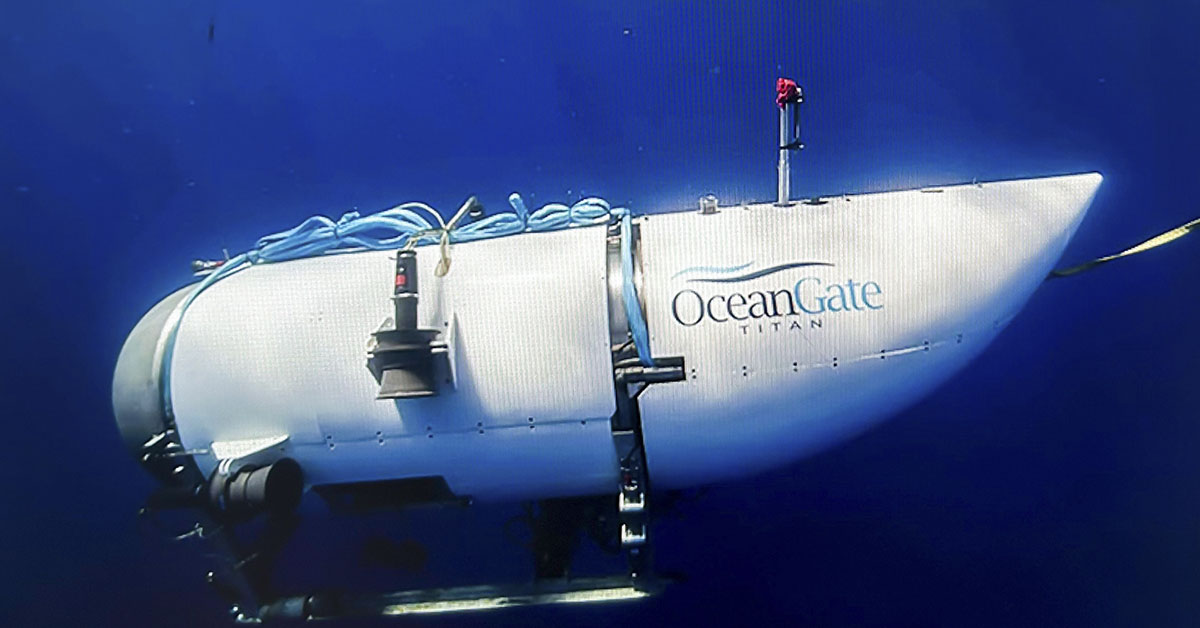The deadly implosion of the Titanic submersible has been roughly recreated by animators online, who have shared videos online to shed light on the swift and devastating nature of the event. These clips, which are on TikTok, portray the 22ft vessel being instantly crushed under the immense ocean pressure, leaving very little behind.
TikTok user @sincerelybootz shared an animated video capturing the haunting moment when a military sub folds in on itself before erupting into a violent explosion.1 The video, posted earlier this week, comes with a chilling statement: “It’s very instantaneous as far as death when it comes to any lives that may be on board.” The animated depiction is a stark reminder of the abruptness and finality that can accompany a catastrophic implosion, not all that dissimilar from the Titanic submersible.
Another animator, @starfieldstudio, added their own visual representation of the Titan’s descent toward the seabed and subsequent implosion.2 Accompanied by a caption describing the events, the animation explains that within a mere 30 milliseconds, the intense pressure would cause the Titanic sub’s hull to heat the air to temperatures similar to the surface of the sun. The force of the collision between metal and seawater would obliterate the vessel, leaving no trace of its former existence.
US Navy Detects Anomaly and Loss of Communication
An official announcement revealed that the US Navy had detected an anomaly in the data from Sunday, believed to coincide with the moment of implosion. The Titanic submersible, launched from a mother ship situated 900 miles off the coast of Cape Cod, experienced a sudden loss of communication and navigation a mere 1 hour and 45 minutes into its journey. These distressing revelations underline the rapid and catastrophic nature of the submersible’s demise.
The aftermath of the Titan’s tragic fate took place on Thursday, as debris from the ill-fated submersible was found over two and a half miles below the surface of the Atlantic Ocean. Four days earlier, the watercraft had lost contact with its crew while on a dive to explore the wreckage of the Titanic. The US Coast Guard confirmed that the recovered debris was consistent with a “catastrophic implosion,” a harrowing indication that the occupants of the submersible likely met a fatal end.
Read: Ocean Gate’s Stockton Rush Had Safety Concerns Before Accident
Recovery Attempts for Titanic Sub
As search and recovery efforts continue, the fate of the passengers remains uncertain. We don’t know yet if the remains of those who lost their lives will be found. The discovered debris, located approximately 1,600 feet from the Titanic wreckage, is a grim reminder of the risks involved in exploring the ocean’s depths. The individuals onboard the ill-fated Titanic submersible had each paid $250,000 to OceanGate Expeditions for the opportunity to explore the historical wreckage.
Among the victims are British billionaire Hamish Harding, Pakistani businessman Shahzada Dawood and his 19-year-old son Suleman, French Titanic expert Paul-Henri Nargeolet, and OceanGate’s CEO Stockton Rush. The loss of these individuals, each with their unique contributions and aspirations, is a devastating blow to their loved ones and the exploration community as a whole.
Investigations Mount
The ongoing investigation focuses on determining the circumstances surrounding the incident involving the vessel. Rush, in the past, openly acknowledged that he had taken a non-conventional approach to the design of the Titanic submersible.3 Departing from the customary use of solid metals like steel or titanium for submersible hulls, Rush incorporated carbon fiber and titanium, breaking established rules. He believed that such rule-breaking fostered innovation and propelled the goal of exploring the ocean’s depths.
Ocean Gate’s diving operations have attracted scrutiny, particularly concerning safety concerns. In 2018, a lawsuit was filed alleging that the company had not adequately addressed issues of quality control and safety. The lawsuit eventually reached a resolution.
A former employee, who raised concerns about quality control and safety specifically related to the Titan, was terminated shortly after voicing these concerns. Experts in maritime regulation also highlighted that Ocean Gate was operating in a legal gray area by utilizing a submersible without industry-standard certification.
Continued Mourning and Reflection
As the investigation and recovery efforts unfold, the grief and mourning for the lives lost in this tragic event continue to resonate. The swift and destructive implosion of the Titanic submersible serves as a somber reminder of the risks inherent in exploring the unknown depths of the ocean. The animation videos shared online provide a haunting visual representation of the catastrophic event, offering a glimpse into the final moments of the ill-fated submersible. As the search for answers and closure continues, the impact of this loss reverberates throughout the exploration and maritime communities, leaving a lasting mark on the memory of those who perished.
Keep Reading: A Lot Of People Are Only Just Finding Out Where The Titanic Actually Sank
Sources
- “Videos show what the Titanic sub’s horrifying ‘implosion’ may have looked like.” Irish Star. Martha Brennan. June 23, 2023.
- “Terrifying TikTok videos depict what may have happened during Titanic sub’s ‘catastrophic implosion’.” NY Post. Steve Janoski. June 22, 2023.
- “OceanGate CEO Stockton Rush said in 2021 he knew he’d ‘broken some rules’ by making the Titanic submersible out of carbon fiber and not pure metal: ‘You’re remembered for the rules you break’.” Yahoo. Matthew Loh. June 23, 2023.

